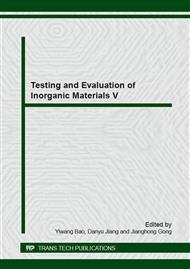[1]
M. R. Hoffmann, S. T. Martin, W. Y. Choi, D. W. Bahnemannt, Environmental Applications of Semiconductor Photocatalysis. Chem. Rev. 95(1995) 69-96.
Google Scholar
[2]
P. A. Pekakis, N. P. Xekoukoulotakis, D. Mantzavinos, Treatment of textile dyehouse wastewater by TiO2 photocatalysis. Water Res. 40(2006) 1276-1286.
DOI: 10.1016/j.watres.2006.01.019
Google Scholar
[3]
M. Ramya, B. Anusha, S. Kalavathy, Decolorization and biodegradation of Indigo carmine by a textile soil isolate Paenibacillus larvae. Biodegradation 19(2008) 283-291.
DOI: 10.1007/s10532-007-9134-6
Google Scholar
[4]
M. M. Assadi, K. Rostami, M. Shahvali, M. Azin, Decolorization of textile wastewater by Phanerochaete chrysosporium. Desalination 141(2001) 331-336.
DOI: 10.1016/s0011-9164(01)85010-4
Google Scholar
[5]
H. M. H. Gad, A. El-Hakim, A. M. Daifullah, Impact of Surface Chemistry on the Removal of Indigo Carmine Dye Using Apricot Stone Active Carbon. Adsorpt. Sci. Technol. 25(2007) 327-341.
DOI: 10.1260/026361707783432588
Google Scholar
[6]
Z. Chen, S. Berciaud, C. Nuckolls, T. F. Heinz, L. E. Brus, Energy transfer from individual semiconductor nanocrystals to graphene. ACS Nano. 4(2010) 2964-2968.
DOI: 10.1021/nn1005107
Google Scholar
[7]
S. P. Gubin, N. A. Kataeva, G. B. Khomutov, Promising avenues of research in nanoscience: chemistry of semiconductor nanoparticles. Russ. Chem. Bull. Int. Ed. 54(2005) 827-852.
DOI: 10.1007/s11172-005-0331-3
Google Scholar
[8]
C. Tian, Q. Zhang, A. Wu, M. Jiang, Z. Liang, B. Jiang, H. Fu, Cost-effective large-scale synthesis of ZnO photocatalyst with excellent performance for dye photodegradation. Chem. Commun. 48(2012) 2858-2860.
DOI: 10.1039/c2cc16434e
Google Scholar
[9]
Y. Lai, M. Meng, Y. Yu, X. Wang, T. Ding, Photoluminescence and photocatalysis of the flower-like nano-ZnO photocatalysts prepared by a facile hydrothermal method with or without ultrasonic assistance. Applied Catalysis B: Environmental. 105(2011).
DOI: 10.1016/j.apcatb.2011.04.028
Google Scholar
[10]
A. G. Joshi, S. Sahai, N. Gandhi, Y. G. Radha Krishna, D. Haranath, Valence band and core-level analysis of highly luminescent ZnO nanocrystals for designing ultrafast optical sensors. Appl. Phys. Lett. 96(2010) 123102-3.
DOI: 10.1063/1.3354025
Google Scholar
[11]
J. H. Lim, C. K. Kang, K. K. Kim, I. K. Park, D. K. Hwang, S. J. Park, UV electroluminescence emission from ZnO light-emitting diodes grown by high temperature radiofrequency sputtering. Advanced Materials. 18(2006) 2720-2724.
DOI: 10.1002/adma.200502633
Google Scholar
[12]
Y. Park, S. H. Kang, W. Choi, Exfoliated and reorganized graphite oxide on titania nanoparticles as an auxiliary co-catalyst for photocatalytic solar conversion. Phys. Chem. Chem. Phys. 13(2011) 9425-9431.
DOI: 10.1039/c1cp20697d
Google Scholar
[13]
G. Williams, B. Seger, P. V. Kamat, TiO2-Graphene Nanocomposites. UV-Assisted Photocatalytic Reduction of Graphene Oxide. ACS Nano 2(2008) 1487-1491.
DOI: 10.1021/nn800251f
Google Scholar
[14]
K. S. Novoselov, A. K. Geim, S. V. Morozov, D. Jiang, Y. Zhang, S. V. Dubonos, I. V. Grigorieva, A. A. Firsov, Electric Field Effect in Atomically Thin Carbon Films. Science 306(2004) 666-669.
DOI: 10.1126/science.1102896
Google Scholar
[15]
W. S. Hummers, R. E. Offeman, Preparation of graphitic oxide. J. Am. Chem. Soc. 80 (1958) 1339-1339.
DOI: 10.1021/ja01539a017
Google Scholar



